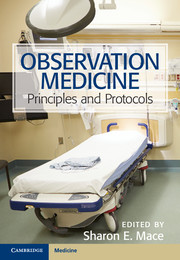Book contents
- Observation Medicine
- Observation Medicine
- Copyright page
- Contents
- Advance Praise
- About the Editors
- Contributors
- Foreword: Onward and Upward
- Preface
- Part I Administration: Key Concepts of Observation Medicine, and Developing and Maintaining an Observation Unit
- Part II Observation Medicine: Clinical Setting and Education
- Part III New Developments in Observation Medicine
- Part IV Clinical
- Part V Financial
- Part VI International
- Part VII Evidence Basis for Observation Medicine
- Chapter 80 The Evidence Basis for Observation Medicine in Adults Based on Diagnosis/Clinical Condition
- Chapter 81 The Evidence Basis for Age-Related Observation Care
- Part VIII Clinical Protocols
- Part IX Administrative Policies
- Part X Order Sets
- Prologue
- Index
- References
Chapter 81 - The Evidence Basis for Age-Related Observation Care
from Part VII - Evidence Basis for Observation Medicine
Published online by Cambridge University Press: 31 March 2017
- Observation Medicine
- Observation Medicine
- Copyright page
- Contents
- Advance Praise
- About the Editors
- Contributors
- Foreword: Onward and Upward
- Preface
- Part I Administration: Key Concepts of Observation Medicine, and Developing and Maintaining an Observation Unit
- Part II Observation Medicine: Clinical Setting and Education
- Part III New Developments in Observation Medicine
- Part IV Clinical
- Part V Financial
- Part VI International
- Part VII Evidence Basis for Observation Medicine
- Chapter 80 The Evidence Basis for Observation Medicine in Adults Based on Diagnosis/Clinical Condition
- Chapter 81 The Evidence Basis for Age-Related Observation Care
- Part VIII Clinical Protocols
- Part IX Administrative Policies
- Part X Order Sets
- Prologue
- Index
- References
Summary
In this chapter, we examine and summarize the evidence for observation care based on age, for example, the pediatric and geriatric population, as the previous chapter did for adults with a given condition or diagnosis, such as chest pain or asthma. The critical questions addressed in this chapter are:
1. Can infants and children (e.g., pediatric patients) be successfully and safely treated in an observation unit setting?
2. Can geriatric patients be successfully and safely treated in an observation unit setting?
- Type
- Chapter
- Information
- Observation MedicinePrinciples and Protocols, pp. 478 - 502Publisher: Cambridge University PressPrint publication year: 2017



